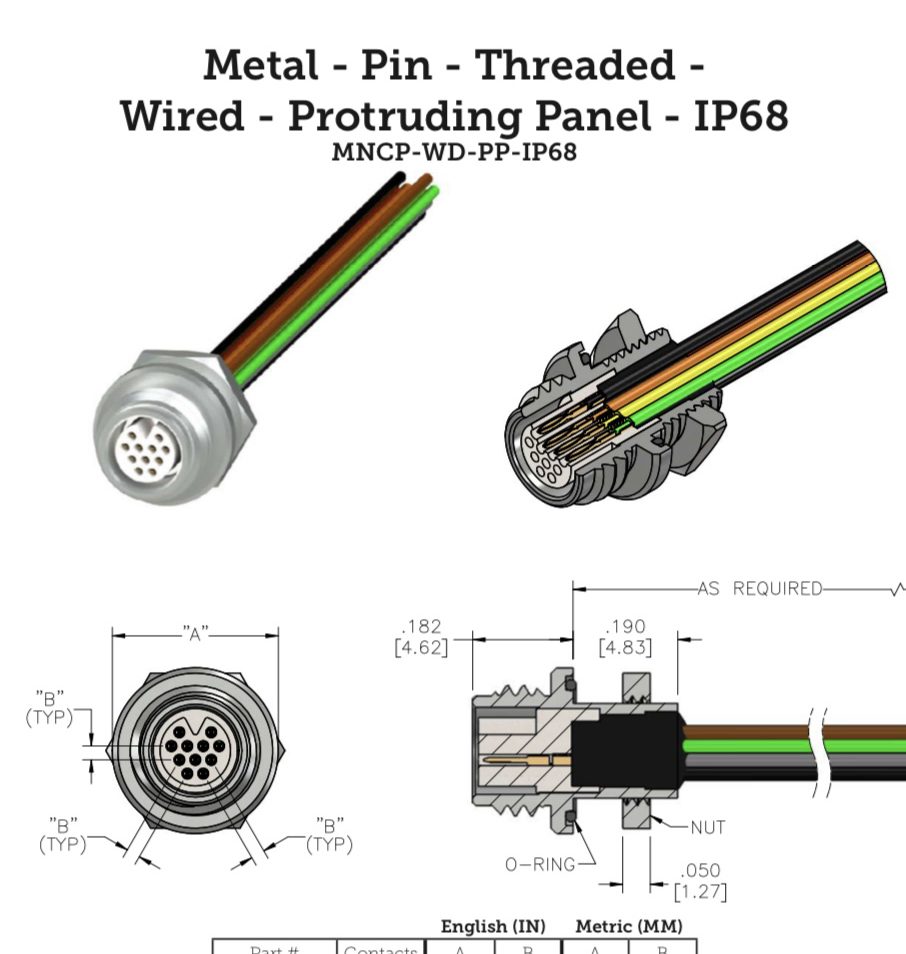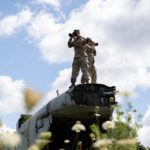Nano-Circular Connectors for Sensor Designs in Rugged Applications
As we place sensors in more rugged environments and extend their uses beyond flat mounting applications, nano-circular connectors and round cable rise to lead in solution-based design strategies.

New data-acquisition and information-monitoring technologies have given rise to a completely new field of high-speed image detectors, material sensors, pressure monitors, and even inertia monitors. Today, drones, robotics, automobile safety devices, and medical alert devices provide us with information, alerts, and warnings. Many of these functions depend on a partnership from the sensors and the interconnections that feed data throughout instruments.

Nano-circular connectors are an essential solution for rugged, lightweight, and high-reliability applications. Omnetics offers a variety of materials, shielding options, sizes, shell types, and mounting options for these versatile connectors.
Satellite constellations monitor Earth in hundreds of ways. In the military, they transmit vital information about potential trouble spots and active war zones. Autonomous defense systems provide advanced information as ground troops are monitored and data is communicated through satellites. The satellites forward data to defense command analysis centers, where response decisions are made, including missile responses. Informed by data, missiles can locate, track, and attack targets at supersonic speeds. Small, ruggedized nano-circular connectors and cable are a significant part of these new designs.

Nano-circular connectors play a key role in automation technologies, enabling motion and enduring rigorous operation without loss of connectivity.
Applying new sensor chips into miniature circuits has become one of the key methods of expanding the digitization of our world’s data. Active sensing elements are often placed where the action is. In automated manufacturing systems, the sensors are positioned at the end of the operating arm or immediately in line with a surveillance module. In medicine, remote surgery tools appear somewhat large as they loom over a patient, but miniature video monitors and device control units are attached at the end of robotic arms. These are then connected via wiring to the main system. In missile weapons, sensors send direction and angle data by wiring to ailerons or fins at the back of the device. Advanced sensors extend out into the key detection area to collect data, which is sent to a small control element called a “seeker head” in the front of the missile. These detection-and-tracking systems guide the missile from the highest inertia analysis and data processing module located deeper within the machine.

In a typical missile seeker head, nano-circular connectors transmit data collected by a range of sensors that help guide the device.
Connecting sensors to instrumentation is a critical portion of the design cycle. One must plan for long-term signal integrity and performance reliability as we place these modules in unique environmental situations. For example, when body-mounted sensors are placed on the forearm of a soldier, they appear to function quite well with the use of a thin-film flex circuit that conforms to the body. When sensors are stacked into a group of circuit boards inside a small sat cube, the ribbon cable system wraps neatly from board to board in a tight, low-profile plane. Things can become complicated, however, when sensors are mounted onto a military drone used to take images from higher altitudes, for example. The sensors, mounted onto the ends of extended propeller controllers, will experience constant vibration, wide ranges of temperatures, and the physical shock of hard landings. The challenge is to plan a size, shape, and structure that will ensure form, function, and reliability under demanding conditions. Electrically, the interconnections must also maintain signal integrity during the unit’s life.

Small, lightweight connectivity solutions such as nan0-circular connectors help reduce payload in tactical equipment such as autonomous drones.
Nano-circular connectors and cables add some great advantages to adapting sensors to new equipment and machinery. Many sensors, fortunately, require low voltages and function on minor current levels. They can operate on modest power supplies or battery packs. Much of the signal data is low level, running at higher digital speeds. The physical architecture of the robot or sensor device will have a data collection and processing module in or near the center of the system. Nano-sized wiring can be designed and routed to fit within the system, can bend and flex in multiple directions if needed, and is easily connected into the back housing of a round nano-circular connector shell.

The small, lightweight cabling behind nano-circular connectors helps designers engineer small-scale yet powerful devices. Here, Omnetics’ watertight nano-circulars help design high-reliability into equipment that may operate in outdoor environments.
Nano connectors and small round wires best fit instruments under these conditions:

Nano-circular connector designs and formats fit many applications. The basic elements begin by selecting pin and socket elements used in military standards and tested for rugged reliability and repeated use. (For example, pins and sockets taken from MIL-STD-83513 or MIL-STD 32139.) The MIL standards control connector body shape, size, and manufacturability by multiple manufacturers, as well as intermatability, if required. Military-tested or rugged-tested custom connectors are increasingly used because they can be fitted to small new circuit mobility systems and still be considered rugged if they use parts taken from full MIL-STD qualified designs.

Omnetics’ rugged polymer Nano 360º connectors are designed to withstand the shock and vibration that is present in many high-reliability applications, in a small and lightweight configuration that helps achieve SWaP goals.
These beryllium copper (BeCu) flex pins are nickel- and gold-plated and have exceeded complete testing for field and extreme environmental applications. Similarly, insulators are molded from the same materials used in micro and nano-D connectors. Signal pins and socket elements are often fit into circular patterns at .025” (.635 mm) spacing in the insulators. Outside metal shell options include push-pull, quick-disconnect, twist lock, and custom shapes to fit unique applications. Molded polymer outer shells are also formed and designed to match specific needs. These smaller devices have less mass and can withstand higher shock and vibration than most large designs.

Miniaturization is critical for robotics, small sats, and other lightweight, small form factor designs. Omnetics’ nano-circulars provide MIL-spec quality and reliability with COTS availability.
When applications use multiple connection cycles, nano-circular connectors exceed 2,000 cycles without apparent wear or performance degradation. Cable design adds significantly to the performance, including signal speed and integrity. The connector format is selected for quick-plug in or pull-in portable camera and/or communication applications. In addition, as speed goes up, proper cable shielding and drain wire interconnections increase accuracy of the system and help ensure appropriate eye pattern quality. (Eye patterns are used to evaluate the combined effects of channel noise and interference of pulsed-transmission systems inside the cable.) Shielding also improves the transmitted signal through the connector and cable assembly and reduce jitter and crosstalk. Reduced size, lower weight, and ruggedness immediately follow in the list of important specifications to serve for examples such as portable ground troop electronics, airborne equipment (such as UASs and UAVs), and in satellite systems. These powerful systems are giving us a better understanding of complex situations with a rich array of data collected by the smallest of interconnects.

Omnetics’ metal nano-circular connectors can be configured to include IP levels of sealing.
Finding the best nano-circular and mating cable for an application begins with reviewing the list of specific requirements above. The next step can include reviewing current standard designs offered by your supplier and checking their proven experience and test data. Selecting an existing design can save time in modeling the final design. If you need changes, work with your connector supplier’s solid model specialist. Online solid modeling and 3D samples for early prototypes are part of the new era. System designers are encouraged to call and work directly with connector designers for application-specific adjustments to current MIL-quality connectors. Most solid models should take less than two days, and 3D fabrication takes less than two days. In a week, you can place it into your circuitry for fit and confirmation.
For more information, visit Omnetics Connector Corp.
Like this article? Check out our other Harsh Environment and High Reliability articles, our Mil/Aero Industry articles, and 2022 Article Archives.
Subscribe to our weekly e-newsletters, follow us on LinkedIn, Twitter, and Facebook, and check out our eBook archives for more applicable, expert-informed connectivity content.
- Miniaturized High-Reliability Interconnects Fuel Medical Device Advancements - February 7, 2023
- Nano-Circular Connectors for Sensor Designs in Rugged Applications - March 22, 2022
- Miniature Connectors Empower Military Robotics - September 28, 2021





